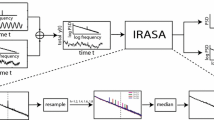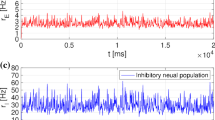Abstract
Fractal dimension has been proposed as a useful measure for the characterization of electrophysiological time series. This paper investigates what the pointwise dimension of electroencephalographic (EEG) time series can reveal about underlying neuronal generators. The following theoretical assumptions concerning brain function were made (i) within the cortex, strongly coupled neural assemblies exist which oscillate at certain frequencies when they are active, (ii) several such assemblies can oscillate at a time, and (iii) activity flow between assemblies is minimal. If these assumptions are made, cortical activity can be considered as the weighted sum of a finite number of oscillations (plus noise). It is shown that the correlation dimension of finite time series generated by multiple oscillators increases monotonically with the number of oscillators. Furthermore, it is shown that a reliable estimate of the pointwise dimension of the raw EEG signal can be calculated from a time series as short as a few seconds. These results indicate that (i) The pointwise dimension of the EEG allows conclusions regarding the number of independently oscillating networks in the cortex, and (ii) a reliable estimate of the pointwise dimension of the EEG is possible on the basis of short raw signals.
Similar content being viewed by others
References
Achermann P, Hartmann R, Gunzinger A, Guggenbühl W, Borbely AA (1994) All-night sleep EEG and artificial stochastic control signals have similar correlation dimensions. Electroencephalogr Clin Neurophysiol 90:384–387
Aertsen A, Arndt M (1993) Response synchronization in the visual cortex. Curr Opin Neurobiol 3:586–594
Berge P, Pomeau Y, Vidal C (1986) Order within chaos. Wiley, New York
Braitenberg V (1978) Cell assemblies in the cerebral cortex. In: Heim R, Palm G (eds) Theoretical approaches to complex systems. Lecture notes in biomathematics, vol 21. Springer, Berlin Heidelberg New York, pp 171–188
Broomhead DS, King GP (1986) Extracting qualitative dynamics from experimental data. Physica D 20:217–236
Eckhorn R, Bauer R, Jordan W, et al. (1988) Coherent oscillations: a mechanism of feature linking in the visual cortex? Biol Cybern 60:121–130
Eckmann JP, Ruelle D (1992) Fundamental limitations for estimating dimensions and Lyapunov exponents in dynamical systems. Physica D 56:185–187
Elbert T, Rockstroh B (1987) Threshold regulation: a key to the understanding of the combined dynamics of EEG and event related potentials. J Psychophysiol 4:317–333
Elbert T, Ray WJ, Kowalik ZJ, Skinner JE, Graf KE, Birbaumer N (1994) Chaos and physiology: deterministic chaos in excitable cell assemblies. Phys Rev 74:1–47
Farmer JD (1982) Information dimension and the probabilistic structure of chaos. Z Naturforsch 37a:1304–1325
Farmer JD, Ott E, Yorke JA (1983) The dimension of chaotic attractors. Physica D 7:153–180
Gray CM, Singer W (1989) Stimulus-specific neuronal oscillations in orientation columns of cat visual cortex. Proc Natl Acad Sci USA 86:1698–1702
Gray, CM, König P, Engel AK, Singer W (1989) Oscillatory responses in cat visual cortex exhibit inter-columnar synchronization which reflects global stimulus properties. Nature 338:334–337
Hebb DO (1949) The organization of behavior: a neuropsychological theory. Wiley, New York
Lutzenberger W, Elbert T, Birbaumer N, Ray WJ, Schupp HT (1992) The scalp distribution of fractal dimension of the EEG and its variation with mental task. Brain Topogr 5:27–34
Osborne AR, Provenzale A (1989) Finite correlation dimension for stochastic systems with power-law spectra. Physica D 35:357–381
Packard NH, Crutchfield JP, Farmer JD, Shaw RS (1980) Geometry from a time series. Phys Rev Lett 45:712–716
Palm G (1987) Comments on the paper ‘Threshold regulation: a key to the understanding of the combined dynamics of EEG and eventrelated potentials’ by T. Elbert and B. Rockstroh. J Psychophysiol 4:335–337
Preissl H, Aertsen AMHJ (1992) Reconstruction and characterisation of neuronal dynamics: How attractive is chaos? In: Aertsen A, Braitenberg V (eds) Information processing in the cortex: experiments and theory. Springer, Berlin Heidelberg, New York, pp 285–297
Procaccia I (1988) Complex or just complicated? Nature 333:489–499
Pulvermüller F, Preissl H, Eulitz C, Pantev C, Lutzenberger W, Elbert T, Birbaumer N (1994) Brain rhythms, cell assemblies, and cognition: evidence from the processing of words and pseudowords. Psycoloquy 5 (48)
Röschke J, Aldenhoff J (1991) The dimensionality of human's electroencephalogram during sleep. Biol Cybern 64:307–313
Röschke J, Aldenhoff JB (1992) A nonlinear approach to brain function: deterministic chaos and sleep EEG. Sleep 15:95–101
Singer W (1994) Putative functions of temporal correlations in neocortical processing. In: Koch C, Davis J (eds) Large scale neuronal theories of the brain. MIT Press, Boston, Mass
Skarda CA, Freeman WJ (1987) How brains make chaos in order to make sense of the world. Behav Brain Sci 10:161–195
Smith LA (1988) Intrinsic limits on dimension calculation. Phys Lett A 133:283–288
Theiler J (1986) Spurious dimensions from correlation algorithms applied to limited time series data. Phys Rev A 34:2427–2432
Vastano JA, Kostelich EJ (1986) Comparison of algorithms for determining Lyapunov exponents from experimental data. In: Mayer-Kress G (ed) Dimensions and entropies in chaotic systems. Springer, Berlin Heidelberg, New York, pp 100–107
Young LS (1982) Dimension, entropy and Lyapunov exponents. Ergod Th Dynam Sys 2:109–124
Author information
Authors and Affiliations
Rights and permissions
About this article
Cite this article
Lutzenberger, W., Preissl, H. & Pulvermüller, F. Fractal dimension of electroencephalographic time series and underlying brain processes. Biol. Cybern. 73, 477–482 (1995). https://doi.org/10.1007/BF00201482
Received:
Accepted:
Issue Date:
DOI: https://doi.org/10.1007/BF00201482




